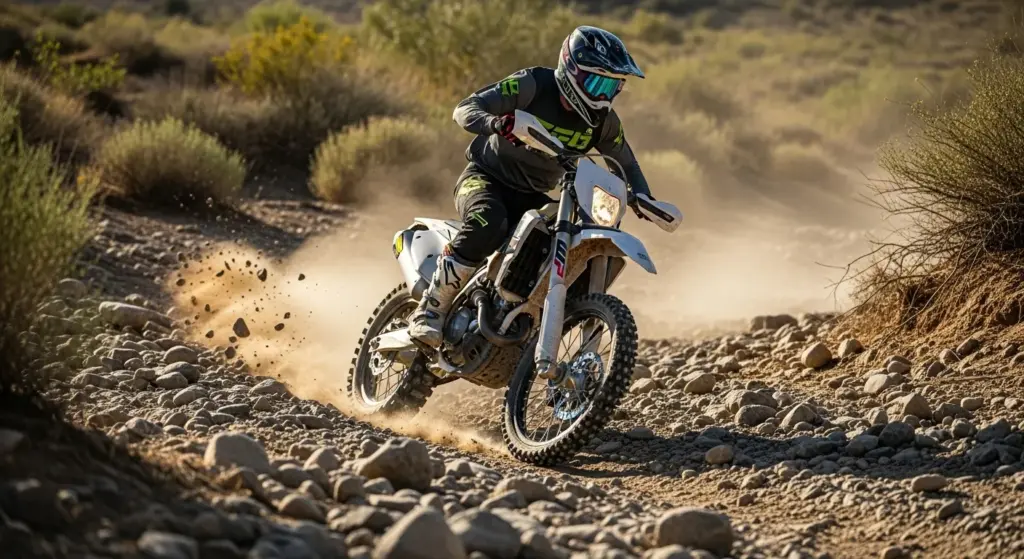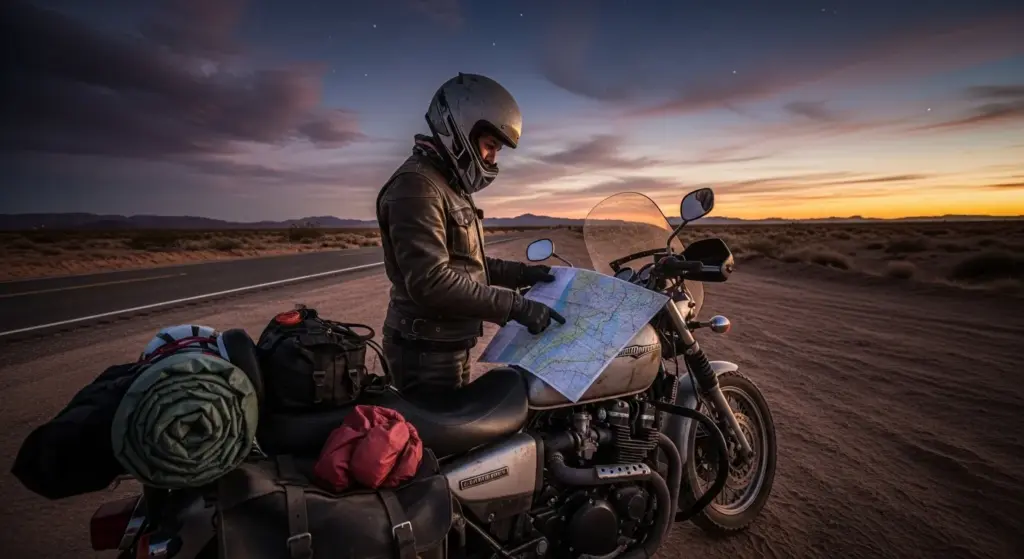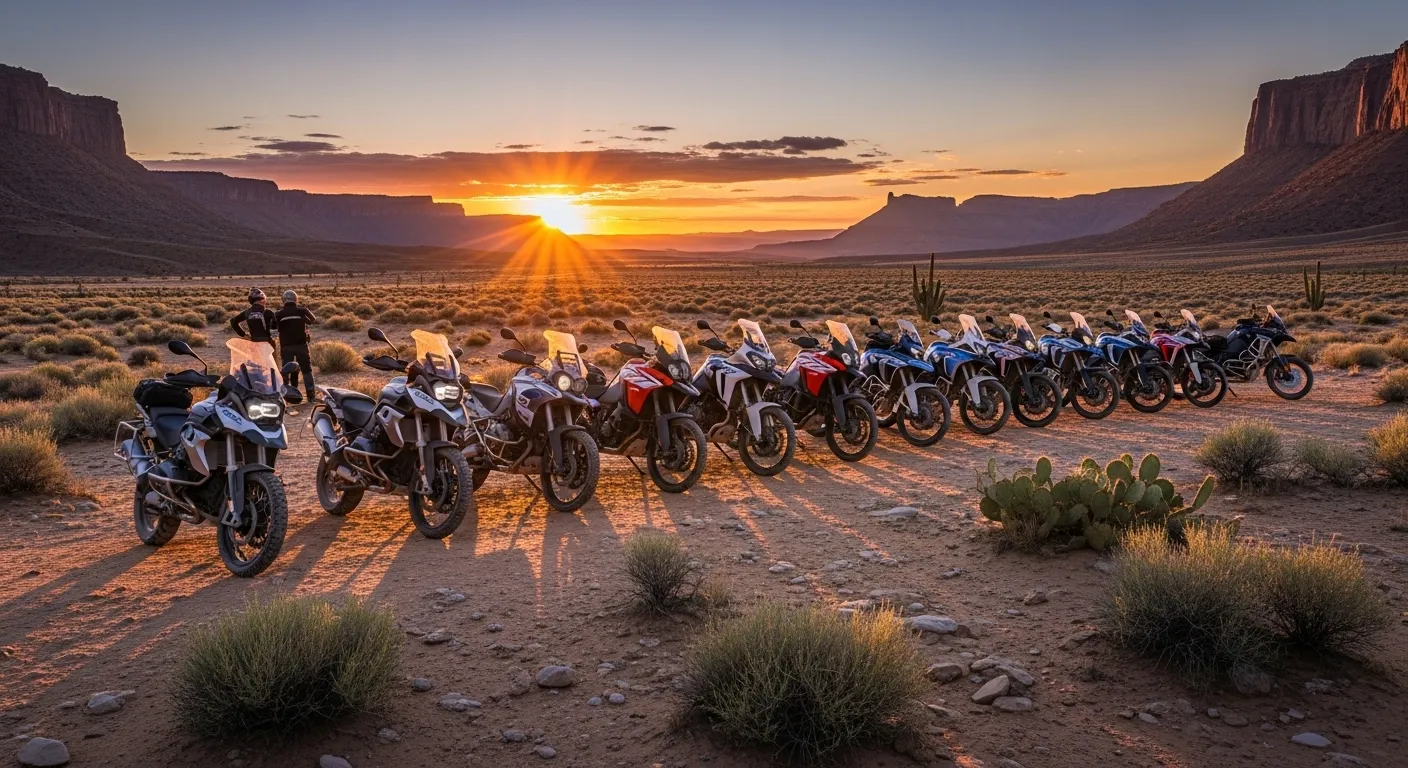Last updated on November 7th, 2025 at 11:47 pm
There’s something magnetic about the American West. From Utah’s slickrock and Arizona’s dusty washes to Nevada’s open highway strips and California forest passes — it calls for bikes that are equal parts rugged, reliable, and ready for everything in between. That’s why, when selecting the top 10 adventure bikes for Western U.S. terrain, I looked not just at specs — but at how they feel under a high sun, in thin air, over gravel, asphalt, and broken pavement.
These bikes aren’t just machines — they’re your partners on routes like the Loneliest Road, the Mojave, or the trails of Moab. Below are picks that combine real-world usability, durability, offroad grit, and endurance — the ones I’d pick if I were packing up for a multi-state Western ride.
What “Adventure Ready for the West” Means

Before the list: a quick yardstick. An adventure bike for the American West needs:
- High ground clearance & long suspension travel — to handle desert washouts, mesa roads, and forest debris
- Reliable cooling & heat tolerance — the heat in Utah or Nevada will punish machines without robust cooling
- Fuel range & luggage options — big gaps between stations demand smart fuel systems and good luggage compatibility
- Ease of maintenance & parts support — when you’re 150 miles from town, simplicity matters
- Electronics that help, not overwhelm — traction control, ABS, ride modes are useful, but not if they confuse or fail mid-dust storm
With that in mind, here are the ten machines I believe deliver when the Westward call comes.

1. BMW R 1300 GS
When you imagine a bike conquering the West, the BMW R 1300 GS often fits the mental picture. Its boxer twin now delivers ~145 hp and 110 lb-ft of torque, while shedding weight over its predecessor.
Its shaft drive is nearly foolproof long-term, and BMW’s service network in the U.S. is one of the most dependable. The adaptive electronics, cruise control, and integrated luggage systems make long highway slabs less punishing. Off-road, it’s competent — not extreme — but it’s stable in gravel and forgiving over washboard.
Why it shines in the West: The R 1300 GS handles altitude changes, steep grades, and highway burns with composure. Want to sprint from Zion to Twin Falls? It’ll do that. Need to scratch into slickrock side routes? It won’t flinch.
Possible downsides: Taller seat height, heavier than midweights. If you’re frequently in technical single-track or deep sand, it’s not a full enduro but a high-capability all-rounder.
2. KTM 890 Adventure / 890 Adventure R
KTM’s 890 Adventure line (and especially the R variant) is a favorite among riders who demand both off-road agility and highway competence.
It punches well above its class — strong torque, responsive engine, nimble handling. The 890 R brings more suspension travel and more aggressive settings. It’s a bike that doesn’t feel overburdened when the terrain gets loose.
Why it fits the West: The 890’s lighter footprint means you can more readily tackle side trails off the beaten path. You’ll appreciate its flickability in slot canyon runoff routes and its stamina on paved mountain passes.
Trade-offs: KTM’s service coverage is decent, but in very remote areas you’d prefer a bike whose parts are easier to source. Also, highway comfort is good, but long slab miles will show its sportier edges more than on big touring rigs.
3. Triumph Tiger 900 Rally (or Rally Pro)
You already know about the 2026 Tiger 900 Rally, but it belongs on this list not just as a subject piece — it’s a genuine contender for Western adventures. Its 888cc triple is torquey, its suspension forgiving, electronics mature. (We covered its updates in depth in our last piece.)
With luggage, good wind protection, and a balance between off-road and road modes, it’s one of those rare bikes that doesn’t force you to sacrifice either world. The color schemes and component refinements for 2026 only increase its appeal in remote settings (less glare, fewer hot spots, more durability).
Why Western riders will like it: It’s nimble enough for gravel sidetrack detours, yet composed on highway stretches between fuel stops. Its triple engine pulls confidently up steep grades, useful in the canyons. It’s not the heaviest, and it’s not the lowest seat height — but it’s arguably one of the most well-balanced in the class.
4. Yamaha Ténéré 700 / Ténéré 700 World Raid
The Yamaha Ténéré 700 is a simplicity-first approach to adventure — less about gadgets, more about reliable capability. Its parallel twin isn’t the most powerful, but its ease of maintenance, light weight, and ruggedness make it popular among overlanders. Visordown+1
The World Raid version ups the fuel capacity, adds better suspension, and improves electronics for touring use. When you’re crossing deserts with few support services, simplicity often wins.
West advantage: Low weight means you can explore narrower side trails. The less complex design is easier to maintain far from service centers. It doesn’t intimidate with complexity, but it performs.
Limitations: On long highway stretches with heavy loads or multiple passengers, it lacks the outright power of twins or triples. But in many Western use cases — solo or light loads — it’s more than enough.
5. Ducati DesertX
Ducati’s DesertX carries with it Ducati’s heritage of adventure racing styling and serious off-road intention. It’s bold in looks and starts conversations wherever it parks. The chassis and suspension are built to handle serious terrain without losing composure on pavement.
What makes it special in the West: The DesertX is built with desert crossings in mind. When the terrain turns rocky, washboarded, or loose, it’s confident. Ride it through a dusty wash, then chase the sunset across Highway 395 — it holds its own.
Watch out for: Seat height and comfort over prolonged highway miles may not compete with pure touring rigs. Service availability (for Ducati-specific parts) is more limited in remote regions.
6. Honda XL750 Transalp
This newer entry from Honda brings a balanced middleweight option. The XL750 Transalp pairs thoughtful ergonomics, Honda’s renowned parts network, and enough performance for Western touring.
It doesn’t dominate in any single domain, but its consistency across domains makes it compelling. For riders who prefer “no surprises,” it’s a strong choice.
Why it appeals for West travel: If your route involves frequent paved connectors and moderate off-road segments, the Transalp is a dependable partner. Its lower service cost and parts availability across the U.S. are plus points for remote travel.
Caveat: It may lag in outright off-road capability compared to the KTM or DesertX. It’s less aggressive in suspension travel.
7. Suzuki V-Strom 650 / V-Strom 800
The V-Strom 650 has long been a favorite for riders wanting a trustworthy, middleweight adventure-tourer. Its V-twin smoothness and versatility make it suited for mixed terrain.
While not extremecross, its strengths are in usability and comfort. Parts and servicing from Suzuki’s network are a big advantage when you stray from interstate corridors.
**Why the West: **It’s less theatrical than some picks, but for rides that combine paved and graded dirt roads, the V-Strom gives you reliable performance, good comfort, and easier logistics.
Limitation: In aggressive off-road terrain or very remote paths, its suspension and approach angles are more moderate than some of the race-bred models above.
8. Harley-Davidson Pan America 1250 Special
Harley’s entry into the adventure world, the Pan America 1250, surprises many. It’s not just a cruiser with dirt pretensions — it’s a legit adventure machine.
Its liquid-cooled V-twin offers torque, weight is handled smartly, and its electronics focus on real-world usability (cornering ABS, ride modes, etc.). For riders who prefer the Harley brand or want one bike for both touring and adventure detours, it’s a compelling option.
Strengths in the West: The Pan America is good on the highway and stable under load, and capable off-pavement without being overly radical. It’s a versatile option for riders who split time between highways and rougher detours.
Drawbacks: It’s heavier than many midweights, and the parts / service network for adventure bikes is still evolving for HD. Off-road extreme trails may push it beyond its comfortable limits.
9. KTM 390 Adventure (or 2025 Adventure X/R)
While more modest in displacement, the KTM 390 Adventure / Adventure X / R models are excellent for light adventure, daily riding, and trails with moderate terrain.
For riders who want to punch above their license or explore remote routes without dealing with big bikes, this is a nimble option. It’s also lighter, easier to push or maneuver when stuck, and less punishing under mistakes.
Where it works in the West: Ideal for supplemental routes, scenic backroads, or when you want to explore side trails where bigger bikes would overkill.
Where it struggles: Long highway legs with wind buffeting or heavy loads will strain it. Not ideal for loaded two-up touring across vast distances.
10. (Wildcard) Light or Specialty Entry — Bonus Pick
Beyond the typical names, sometimes a light, dependable adventure / dual-sport makes sense in remote areas. Think of bikes like Honda CRF300 Rally, or even specialized dual-sports tuned for desert work (less luggage, more trail geometry). I include this spot not for a specific model but to remind riders: in the American West, sometimes less is more.
A lightweight specialist won’t match highway top speed of big rigs, but it may allow you to reach places that heavier bikes fear.
Spec Table Snapshot (Representative Models)
Below is a comparative snapshot of a few representative models for Western-style riding:
| Model | Engine Type / Displacement | Approx Power | Seat Height | Wet Weight | Fuel Capacity | Notable Strength |
|---|---|---|---|---|---|---|
| BMW R 1300 GS | Boxer twin, 1,300 cc | ~145 hp | High | ~237 kg | ~19 L | Long-haul, service support |
| KTM 890 Adventure R | Parallel twin, 889 cc | ~103 hp | Moderate-high | ~210 kg | 20 L | Off-road balance |
| Triumph Tiger 900 Rally | Inline triple, 888 cc | ~106 hp (refined) | Mid-high | ~228 kg | ~20 L | Balanced go-everywhere option |
| Yamaha Ténéré 700 | Parallel twin, 689 cc | ~72 hp | Moderate | ~220 kg | Larger tank (in World Raid) | Simpler, lighter route options |
These are not exhaustive, but they illustrate how power, weight, seat height, and usability balance in real Western scenarios.
Tips to Pick the Right One for Your Route
- Consider your route mix. If you’ll spend 70% highway and 30% gravel, lean toward highway-capable models. If your plan is 50/50, prioritize suspension, traction, and easier maintenance.
- Parts network matters. KTM, BMW, Honda and Suzuki have better U.S. coverage — that matters when you’re off the beaten path.
- Weight vs. usability. Overloaded big bikes get hot, slow, and scary. A lighter middleweight is often better in minutes of rough terrain.
- Fuel and torque. High-elevation stretches (Colorado, Utah) demand torque more than peak horsepower.
- Maintenance simplicity. Fewer exotic parts, easier access to filters, coolant lines, etc., will reduce roadside anxiety.
